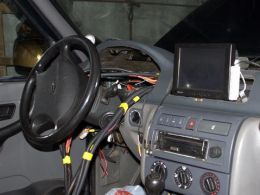Estonia, EU – Baltic States, Technology, Transport
International Internet Magazine. Baltic States news & analytics
Friday, 02.01.2026, 05:32
Estonian Feanor tests some ideas for anti-jamming systems for UAVs
 Print version
Print version |
|---|
The idea comes analyzing the recent case of the UAV forced to landing by jamming its navigation system.
By putting noise (jamming) on the communications with the satellite (the UAV was far from its closest control station) , the UAV was probably forced into autopilot RTL mode (Return To Launch).
At that time the UAV relies on GPS signals to get home. By spoofing the GPS (although not trivial if it was using, as it should be, a cripted M-code), jammers were able to have the UAV land on its own where they wanted it to, without having to crack the remote-control signals and/or satellite communications data link.
The idea is actually nothing special, it uses redundancy and a preferred track to convicne the jammer that he got control over the system, i.e. uses more independent GPS sensors controlling each other on the same platform and then let just one of them being 'fooled' by the jamming, while the other maintain correct information and drive the UAV back to its real home.
A compass and some accelerometers (or even a view of the sun and an RTC) are a lousy substitute for the accuracy of GPS; but they would provide a 'sanity check' that could keep the UAV going in approximately the right direction, at least enough to hard-land somewhere nominally friendly, if GPS cannot be trusted.
It's certain that the UAV had an inertial navigation system – the problem is, how do you know when to use it? The way they usually work is that the navigation system computes two solutions: a hybrid GPS/INS solution to use most of the time, and a backup inertial-only solution. The inertial-only solution doesn't get used by the flight computers unless GPS is out entirely or there's some other very obvious problem. If you spoofed a GPS signal with real coordinates and slowly guided it away, it is not obvious for the navigation system to see that there's something wrong.
Inertial navigation systems need reference points to prevent huge drifts over time. This is especially a problem if the aircraft flies relatively straight at the same speed for a long time –- accelerometers won't be able to detect slight changes in course. GPS is used to provide the reference points to reduce the drift. If the GPS system is wrong, then the inertial nav system is also going to be fooled.
Roadmap
We first test a very cheap solution based on Ardupilot with Air Shield (pressure sensor), no thermopiles, and an ArduIMU V2 instead, connected to a Mediatek 10Hz GPS. This with be 'sacrificed' and will talk to the jamming system (jammer), trying to make sure he thinks he is in control and following its instructions.
Other two GPS receivers, i.e. a uBlock (binary) and and EM-406 Sirf with different protocols would stay behind, protected from the jammer by a firewall, and fly the UAV back to a safe home position. The system is based on open-source data and limited, through Xbee telemetry, to 1.2 km. Next step will be performed on a remote system up to 40 km and finally on a satellite datalink next year, all platforms being provided by an UAV manufacturer in China.








 «The Baltic Course» Is Sold and Stays in Business!
«The Baltic Course» Is Sold and Stays in Business!

